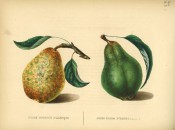Pyrus communis ‘Doyenné Marbré’
Fruit; medium sized, oval, curved. Skin; pea green ripening to yellowish, thickly dotted, sometimes grey or green. Flesh; yellowish, tender, buttery, melting, slightly gritty at the core, sweet, rich and highly flavoured. Produces a vigorous tree and is an abundant bearer. An excellent late pear. Ripening December to March. [Herefordshire Pomona].
Horticultural & Botanical History
Figured in Le Jardin Fruitier du Muséum as ‘De Luçon’ [JFM vol.2/1859] and as ‘Doyenné d’Alençon’ in Album de Pomologie [ADP vol.1, pl.48/1847], the illustration used here.
It resembles the ‘Easter Beurré’ and is often confused with it [Herefordshire Pomona]. Most contemporary references give ‘Doyenné Marbré’ as a synonym of ‘Easter Beurré’. Its origins have been lost but the synonyms suggest that it is of much more recent introduction than ‘Easter Beurré’.
History at Camden Park
Listed only in the 1857 catalogue in an Addendum as ‘Doyenne Marbre’ [Pear no.55/1857]. Listed in the diary under this name but with no comment. [Diary B, MP A2951/1862]. Obtained from Veitch’s Nursery, probably the original Exeter premises.
Notes
Published May 20, 2010 - 03:20 PM | Last updated Jul 22, 2011 - 01:25 PM

Pear ‘Doyenné Marbré’ | ADP vol.1, pl.48/1847 as Doyenné d’Alençon | Pomologische Bibliothek. Doyenné d’Alençon is the yellow pear on the left.
| Family | Rosaceae |
|---|---|
| Category | |
| Region of origin | Garden origin, unknown |
| Synonyms |
|
| Common Name | Dessert Pear, winter and spring |
| Name in the Camden Park Record |
Doyenne Marbre |
| Confidence level | high |